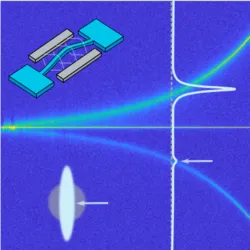Nonlinear dynamics of High Q nanomechanical resonators
We demonstrate a conceptually new and radically simple technique to probe squeezed fluctuations. So far, squeezing has been conventionally quantified in phase-sensitive measurements tracking the fluctuations in phase space. By contrast, we characterize the squeezed state through a spectral measurement. To this end, we employ a nanomechanical resonator of extremely high quality operated in the classical regime. Its thermal fluctuations are squeezed by driving it into a nonlinear regime. The measured power spectrum exhibits two clearly resolved satellite peaks around the drive frequency. Theoretical analysis shows that the peaks’ heights encode the squeezing parameter, which can hence be directly extracted from the power spectrum.
Our results demonstrate that, in driven systems, squeezing can be revealed and characterized in a single shot measurement of the power spectrum. The concept is generic and is not limited to the presented case of a classical resonator, but fully applies in the quantum regime as well. It provides a new perspective on the squeezing of fluctuations and thus should further extend its important applications, including high-resolution sensing and signal processing.
See: Huber et al.,Phys. Rev. X 10, 021066 (2020)
Further research on nonlinear high Q nanoresonators addresses the multiphoton amplification and squeezing by a nonlinear nanomechanical mode (J.S. Ochs et al., arXiv:2007.15382), effects arising from resonantly induced friction (M.I. Dykman et al., Phys. Rev. Lett. 122, 254301 (2019)),
as well as the dispersive coupling and parametric effects in multimode resonator systems
(K. Gajo et al., Phys. Rev. B 101, 075420 (2020) und M. Seitner et al., Phys. Rev. Lett. 118, 254301 (2017)).
Funding and Duration
( Groups),
Duration:
Cooperation Partners
Technische Universität München TUM
External
Contact
TUM: Prof. Eva Weig,
External:
Doctorial Candidates: N.N.
Homepage
